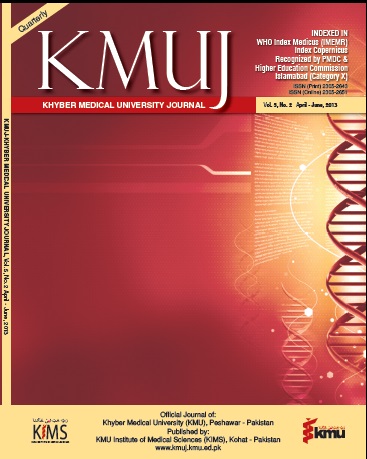INDICATIONS OF TRANSESOPHAGEAL ECHOCARDIOGRAPHY IN A TEACHING HOSPITAL OF PESHAWAR
Main Article Content
Abstract
OBJECTIVE: To analyze the indications of trans-esophageal echocardiography (TEE) in a teaching hospital of Peshawar.
METHODOLOGY: Data collected from April 2003 to September 2009. Consecutive male and female adult patients, who presented to Echo section of Hayatabad Medical Complex for TEE, were included in the study. Information gathered included demographic data, indications, findings, clinical applications and complications of the procedure. Data was expressed as frequencies, percentages, means and standard deviations. RESULTS: A total of 175 cases of TEE were included after excluding 23 repeated procedures, over a period of 6 years. 94 (54%) were female. The patients ranged in age from 13 to 82 years with a mean age of 31±18 years. All the TEE were done in adult echo section. The most frequent indication for TEE was for the evaluations of left atrium (LA) and left atrial appendage (LAA) clot 71 (40.5%), followed by evaluation of infective endocarditis (IE) in 35 (20%) and evaluation of congenital heart disease (CHD) in adults in 35 (20%) cases. No major complication and no mortality recorded related to the procedure.
CONCLUSION: TEE has been most commonly performed in Hayatabad Medical Complex to evaluate LA/LAA clot followed by IE and CHD without any major complications.
Article Details
Work published in KMUJ is licensed under a
Creative Commons Attribution 4.0 License
Authors are permitted and encouraged to post their work online (e.g., in institutional repositories or on their website) prior to and during the submission process, as it can lead to productive exchanges, as well as earlier and greater citation of published work.
(e.g., in institutional repositories or on their website) prior to and during the submission process, as it can lead to productive exchanges, as well as earlier and greater citation of published work.
References
Daniel WG, Mügge A. Transesophageal
echocardiography. N Engl J Med 1995;
: 1268-1279.
Daniel WG, Erbel R, Kasper W, Visser CA,
Engberding R, Sutherland GR, et al. Safety
of transesophageal echocardiography: A
multicenter survey of 10,419 examinations.
Circulation 1991; 83: 817.
Flachskampf FA, Badano L, Daniel WG,
Feneck RO, Fox KF, Fraser AG, et al
Recommendations for transoesophageal
echocardiography: update 2010. Eur J
Echocardiogr 2010; 11: 557-76.
Armstrong WF, Feigenbaum H. Echocardiography.
In: Braunwald E, Zipes DP, Libby
P, Eds. Heart Disease 6Th edition. Philadelphia:
WB Saunders; 2001: 176-220.
Hassan K, Orakzai R, Orakzai S, Shaquat A,
Dhakam S. Transesophageal echocardiography:
Retrospective review and current
clinical applications. Pakistan J Cardiol
; 13: 85-90.
Madu EC, Tulloch-Reid MK, Baugh
DS, Tulloch-Reid E, Potu C. Clinical utility
of transoesophageal echocardiography in
low resource environments: The Jamaican
experience. West Indian Med J 2011;
(6): 653-7.
Prabhu M, Raju D, Pauli H. Transesophageal
echocardiography: instrumentation
and system controls. Ann Card Anaesth
; 15: 144-55.
Cavalcante JL, Rodriguez LL, Kapadia
S, Tuzcu EM, Stewart WJ. Role of echocardiography
in percutaneous mitral
valve interventions. JACC Cardiovasc
Imaging. 2012; 5(7): 733-46.
Ahmad W, Raja MK, Azeem M, Rajput
Z, Abbass S, Rafique A, et al. PTMC in
children and adolescents: The AFIC/NIHD
experience. J Pakistan Inst Med Sci 1997;
(2)8 (1,2): 530-5.
Mügge A, Daniel WG, Haverich A, Lichtlen
PR. Diagnosis of noninfective cardiac mass
lesions by two-dimensional echocardiography:
comparison of the transthoracic and
transesophageal approaches. Circulation
; 83: 70-8.
Willen HJ, Kessler Km. Transesophageal
echocardiography in the diagnosis of diseases
of the thoracic aorta: Part I. Aortic
dissection, aortic intramural hematoma,
and penetrating atherosclerotic ulcers of
the aorta. Chest 1999; 116, 1772-9.
Nienaber CA, Powell JT. Management of
acute aortic syndromes. Eur Heart J 2012;
(1): 26-35.
Baumgartner H, Bonhoeffer P, Natasja M.S,
Groot D, Haan F, Deanfield JE. Guidelines:
ESC Guidelines for the management
of grown-up congenital heart disease: The
Task Force on the Management of Grownup
Congenital Heart Disease of the European
Society of Cardiology (ESC). Eur
Heart J 2010; 31(23): 2915-57.
San Román JA, Vilacosta I, López J, Revilla
A, Arnold R, Sevilla T, et al. Role of
transthoracic and transesophageal echocardiography
in right-sided endocarditis:
one echocardiographic modality does
not fit all. J Am Soc Echocardiogr 2012;
(8): 807-14.
Bhatti MA, Karmarkar R, David WK.
Candida albicans myocardial abscess. J Coll
Physicians Surg Pak 2003; 13(8): 456-8.
Sedgwick JF, Burstow DJ. Update on echocardiography
in the management of
infective endocarditis. Curr Infect Dis
Rep 2012; 14(4): 373-80.
Saeed M, Rahman A, Afzal A, Agoston
I, Jammula P, Birnbaum Y,et al. Role of
transesophageal echocardiography guided cardioversion in patients with atrial
fibrillation, previous left atrial thrombus
and effective anticoagulation. Int J Cardiol
; 113(3): 401-5.
Acsenberg W, Schluter M, Kremer P.Transesophageal
two dimensional echo for the
detection of LAA thrombus. J Am Coll
Cardiol 1986; 7: 163-6.
Sadiq M, Akram Z, butt M, Giovani JVD,
Wilkinson JL, Quraishi S. Transcatheter
occlusion of secundum atrial septal defects
with the self centering Amplatzer septal
occluder initial experience. Pakistan J
Cardiol 2001; 12: 61-6.
Afridi I. Echocardiography in the cardiac
operation room: An essential tool for the
surgeons. Pak J Cardiovasc Thoracic Surg
; 11: 74-80.
Gouveia V, Marclino P, Reuter DA. The role
of transesophageal echocardiography in
the intraoperative period. Curr Cardiol
Rev 2011; 7(3): 184-96.
